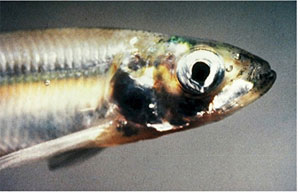 Delta Smelt (Hypomesus transpacificus)
Delta Smelt (Hypomesus transpacificus)
- photo credit: US Fish & Wildlife ServiceThe little delta smelt is back in the headlines. An Alameda County judge has ruled that giant pumps operated by the Department of Water Resources are illegally killing delta smelt and Chinook salmon, two species protected under the California Endangered Species Act (CESA). He has given the state 60 days to obtain the proper permits or shut down the pumps.
I talked to our Senior Scientist, Tina Swanson, about the fish that's been causing so much fuss. As she summed it up, "The delta smelt is a little fish at the center of a huge hurricane."
The fish at issue is petite (generally 2-3 inches), steely blue and nearly translucent. Delta smelt live 1-2 years, feed exclusively on plankton, and, amazingly, smell like cucumbers. The species is endemic to the upper San Francisco Bay and the Delta, meaning it is found nowhere else on earth. Unfortunately, the place it calls home is a place in crisis. And that is cause for concern, even if you don’t happen to be a delta smelt.
The Delta-- where the Sacramento and San Joaquin Rivers converge before flowing into the Bay-- is the heart of the Bay watershed and the hub for much of the state's freshwater supply. 2 in 3 Californians-- some 23 million people-- depend on the system for at least part of their water. (If you live in the East or South Bay, chances are you are one of them.)
The Delta's troubles are manifold. Once a vast and ecologically abundant inland marsh, it was diked and channelized starting in the 1800s. Today, many of its islands have subsided as much as 20 feet below sea level behind aging levee systems, putting farms, homes, our water supply, and human lives at risk (think hurricane Katrina). The rivers flowing into the Delta have been dammed, and water quality suffers due to pesticides and other pollutants from Central Valley and Delta farms. Native species like the smelt are in steep decline, and invasives are taking over. And more and more people are moving into the Delta, building houses on land better suited for flood bypasses or tidal marsh restoration.
